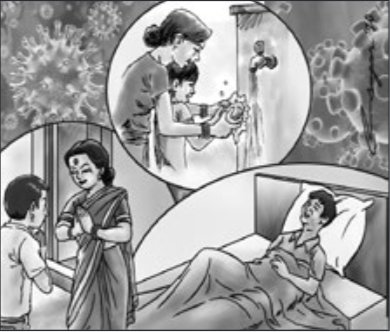COVID-19 prevention: Revive hand washing and social isolation
Age-old customs of maintaining distance, followed by the regular washing of the hands, had gone a little bit out of practice due to blind imitation of the west for no rhyme or reason
The coronavirus has certainly sparked a health crisis across the globe. Nepal could not obviously remain an exception to this global phenomenon. Fortunately for Nepal, only two persons have shown to be infected after seven hundred tests carried out so far, even though doubts have been cast on the accuracy of these tests.
They might as well be correct if history is any indication. In the First World War, nearly 50 million people died in Spain and the neighbouring countries as well as far off United States due to this Spanish flu of the year 1918, also known as influenza. Millions breathed their last in India alone. Even Mahatma Gandhi is said to have been infected by the virus.
In Nepal, not a single person was affected despite the fact that quite a few soldiers, out of the 16,544 trained and several other untrained recruits, returned after fighting bravely but also incurring heavy casualties in the First World War. The Spanish flu did not create havoc perhaps because Nepal then was very thinly populated. There was natural isolation, and the virus could not spread to others.
It is not that the Nepali people have not been on the receiving end of such viruses in the past. In the fourteenth century, about the year 1347, during the reign of King Ari Malla Dev, a deadly plague hit the country, decimating twothirds of the population as in the west.
In the seventeenth century, during the reign of King Bhaskar Malla, an epidemic engulfed the whole of Kathmandu. The king was put in isolation with his two queens and servants. He came running to the palace gleefully jumping from the window after knowing that the mishap had subsided. The king was immediately infected and died soon thereafter in that 1702 plague.
Smallpox has been a regular uninvited guest in Nepal killing several people. The temple of the Mother Goddess, popularly known as Sitala Mai, now mostly deserted, was fervently worshipped till a vaccine led to its complete abolition in Nepal. A rather eccentric King Rana Bahadur Shah paid homage to severl temples and donated significant amounts of money to the Brahmins, wishing for the speedy recovery of his infected queen. He not only demolished several such temples but also snatched the donations back from the priests after his heartthrob, Kantimati, died in the wake of the 1799 smallpox epidemic.
Nepal has been scarred by the multi-killer, cholera, several times in the past. Though cholera outbreak of the year 1821 has been recorded as the first event of its kind in history, it is almost an annual phenomenon in Nepal. In 2009, 500 people lost their life in Jajarkot, and only in 2014, 500 people were affected in Rautahat district in south central Nepal.
A virus, and the coronavirus in particular, is said to be an unknown entity even to the connoisseurs. For the commoners, it is obviously a breathtakingly uphill task to understand. It is said to have its origin in the interaction of the sun rays with the water solvents, leading to the formation of nucleotides, which combine to form nucleic acid. A virus comes into being with the mix-up of this acid and protein. When it enters the living being’s body, which is made up of innumerable cells with a nucleus at the centre, it re-creates infinite number of similar viruses, which together seek to damage the cells leading to illness.
There are only two ways to combatting this coronavirus successfully. The first one is through the use of a vaccine, which injects an anti-virus, known as antibodies, and prevents the spread of the virus. Such a vaccine has not been invented yet, even though scientists around the world are working day and night to arrive at one.
The second one is to stay aloof from each other so that the carrier of the virus is not able to spread onto others. It is against this backdrop that countries around the world are launching lockdown campaigns. India observed a Janata Curfew last Sunday, which was participated by a mammoth one billion and 300 million people. Nepal has also introduced a week-long national lockdown from yesterday.
There is no alternative to isolation in the absence of a tested drug. This method has been adopted in the past in Nepal as could be seen in the case of King Bhaskar Malla. In the case of smallpox and cholera also, the patients are segregated and put aside in our society. The construction of houses on different terraces, and thus fairly apart, also ensures the desired distance, especially in the hills in Nepal.
The regular washing of the hands has been cited as another panacea to this problem. Washing the hands and feet before entering the house has been a regular feature of Nepali culture. This is invariably so before eating, which precedes with the change of clothes by being clad in a white-stripped apparel.
Similarly, the greeting with the twin palms lapping each other since early times in Nepal, pronounced Namaste, has now been adopted worldwide, abandoning the shaking of hands. Age-old customs of maintaining distance, followed by the regular washing of the hands, had gone a little bit out of practice due to blind imitation of the west for no rhyme or reason. The Nepali people should once again revive it to combat the deadly coronavirus forever.






